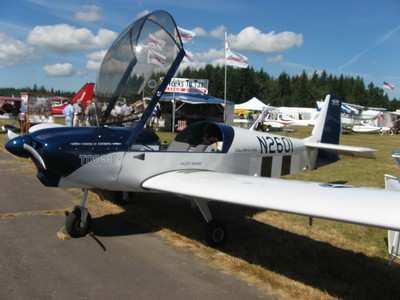Also Cites Concerns With ASTM Standards Used To Certify
LSAs
 ANN REALTIME REPORTING 04.14.09 1615 EDT: The National
Transportation Safety Board today issued an urgent safety
recommendation to the Federal Aviation Administration, asking the
agency to "prohibit further flight" of all CH-601XL light aircraft,
a type that has been involved in six in-flight structural breakups
since 2006.
ANN REALTIME REPORTING 04.14.09 1615 EDT: The National
Transportation Safety Board today issued an urgent safety
recommendation to the Federal Aviation Administration, asking the
agency to "prohibit further flight" of all CH-601XL light aircraft,
a type that has been involved in six in-flight structural breakups
since 2006.
The recommendations apply to the Zodiac CH-601XL, a low-wing,
fixed-gear, single-engine, two-seat general aviation airplane
designed by Zenair. In its urgent safety recommendation, the Board
cited four accidents in the United States and two in Europe
in which the CH-601XL broke up in-flight
killing a total of 10 people.
Aerodynamic flutter -- a phenomenon in which the control
surfaces of the airplane can suddenly vibrate, and if unmitigated,
can lead to catastrophic structural failure -- is suspected in all
of the accidents. The CH-601XL was certified as a Special Light
Sport Aircraft (S-LSA) by the FAA in 2005; before that, the plane
was (and continues to be) available as a kit, or plans-built.
The Safety Board's urgent recommendation to the FAA is to
prohibit further flight of the CH-601XL until they can determine
that the airplane is no longer susceptible to aerodynamic flutter.
The NTSB asserts its investigations of the US accidents point to a
problem with the design of the flight control system, which makes
the airplane susceptible to flutter.

"The NTSB does not often recommend that all airplanes of a
particular type be prohibited from further flight," said NTSB
Acting Chairman Mark V. Rosenker. "In this case, we believe such
action will save lives. Unless the safety issues with this
particular Zodiac model are addressed, we are likely to see more
accidents in which pilots and passengers are killed in airplanes
that they believed were safe to fly."
The Board also found two other areas of concern. The
NTSB says stick force gradient -- a measure of the force
applied to the control stick and the increase in lift that results
-- was not uniform throughout the range of motion,
particularly at high vertical accelerations or Gs. "The
lessening of the gradient at high Gs could make the airplane
susceptible to being inadvertently over-controlled by the pilot,
which could create a condition in which the airplane is stressed
beyond its design limits leading to an in-flight structural
failure."

The NTSB also noted problems with the airspeed indication system
were identified.
"Errors with the correlation between the actual airspeed of the
airplane and that shown on the instruments in the cockpit could
result in the airplane being piloted at airspeeds exceeding design
limits, which could compromise the plane’s structural
integrity. While the airspeed indication issue has not been linked
to any accidents, the Safety Board believes that this is a
safety-of-flight issue that should be corrected."

In addition to the urgent recommendation to the FAA on
prohibiting further flight of the Zodiac CH 601XL, the Safety Board
issued the following seven additional recommendations to the FAA:
1) make a comprehensive evaluation of the wing and aileron system
on the Zodiac CH 601XL to identify design and/or operational
changes that will reduce the potential for flutter; 2) notify
owners of Zodiac CH-601XLs of any design and/or operational changes
to the CH 601XL and require them to implement the changes; 3) work
with ASTM International to incorporate standards for light sport
airplanes that would reduce the likelihood of encountering
in-flight flutter; 4) evaluate the stick force gradient at the aft
center of gravity and especially at the higher Gs, and notify
pilots of such effects; 5) develop standards on stick force
characteristics for light sport airplanes that minimize the
possibility of pilot’s inadvertently over-controlling the
airplane; 6) ensure that the pilot’s airspeed indicator
accurately reflects the Plane’s velocity and update pilot
operating handbooks (POHs) accordingly; and 7) work with ASTM
International to ensure standards for light sport airplanes result
in accurate airspeed indications and appropriate documentation in
new airplane pilot operating handbooks.

Also of note -- and an area of possible concern for the emerging
US light-sport aircraft industry -- the Board also identified
"several areas in which the design standards for light sport
airplanes were deficient." ASTM International provides the
standards that are developed by industry working groups.

The NTSB has asked the ATSM to take the following actions: 1)
Add requirements to ensure the standards for light sport airplanes
reduce the potential for aerodynamic flutter to develop; 2) develop
standards on stick force characteristics for light sport airplanes
that minimize the possibility of pilot’s inadvertently
over-controlling the airplane; and 3) ensure standards for light
sport airplanes result in accurate airspeed indications and
appropriate documentation in new airplane pilot operating
handbooks.
FMI: Read The Recommendation Letters Here And
Here
(.pdf)
 ANN's Daily Aero-Term (04.14.24): Maximum Authorized Altitude
ANN's Daily Aero-Term (04.14.24): Maximum Authorized Altitude ANN's Daily Aero-Linx (04.14.24)
ANN's Daily Aero-Linx (04.14.24) Classic Aero-TV: 'We're Surviving'-- Kyle Franklin Describes Airshow Life 2013
Classic Aero-TV: 'We're Surviving'-- Kyle Franklin Describes Airshow Life 2013 Aero-News: Quote of the Day (04.14.24)
Aero-News: Quote of the Day (04.14.24) Airborne 04.09.24: SnF24!, Piper-DeltaHawk!, Fisher Update, Junkers
Airborne 04.09.24: SnF24!, Piper-DeltaHawk!, Fisher Update, Junkers








